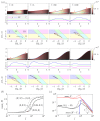Surfactant amplifies yield-stress effects in the capillary instability of a film coating a tube
- PMID: 37799571
- PMCID: PMC7615153
- DOI: 10.1017/jfm.2023.588
Surfactant amplifies yield-stress effects in the capillary instability of a film coating a tube
Abstract
To assess how the presence of surfactant in lung airways alters the flow of mucus that leads to plug formation and airway closure, we investigate the effect of insoluble surfactant on the instability of a viscoplastic liquid coating the interior of a cylindrical tube. Evolution equations for the layer thickness using thin-film and long-wave approximations are derived that incorporate yield-stress effects and capillary and Marangoni forces. Using numerical simulations and asymptotic analysis of the thin-film system, we quantify how the presence of surfactant slows growth of the Rayleigh-Plateau instability, increases the size of initial perturbation required to trigger instability and decreases the final peak height of the layer. When the surfactant strength is large, the thin-film dynamics coincide with the dynamics of a surfactant-free layer but with time slowed by a factor of four and the capillary Bingham number, a parameter proportional to the yield stress, exactly doubled. By solving the long-wave equations numerically, we quantify how increasing surfactant strength can increase the critical layer thickness for plug formation to occur and delay plugging. The previously established effect of the yield stress in suppressing plug formation [Shemilt et al., J. Fluid Mech., 2022, vol. 944, A22] is shown to be amplified by introducing surfactant. We discuss the implications of these results for understanding the impact of surfactant deficiency and increased mucus yield stress in obstructive lung diseases.
Conflict of interest statement
Declaration of interests. The authors report no conflict of interest.
Figures










Similar articles
-
Stability of surfactant-laden liquid film flow over a cylindrical rod.Phys Rev E. 2020 Aug;102(2-1):023111. doi: 10.1103/PhysRevE.102.023111. Phys Rev E. 2020. PMID: 32942402
-
Effects of surfactant on propagation and rupture of a liquid plug in a tube.J Fluid Mech. 2019 Aug 10;872:407-437. doi: 10.1017/jfm.2019.333. Epub 2019 Jun 10. J Fluid Mech. 2019. PMID: 31844335 Free PMC article.
-
Effect of an insoluble surfactant on the dynamics of a thin liquid film flowing over a non-uniformly heated substrate.Eur Phys J E Soft Matter. 2018 May 7;41(5):56. doi: 10.1140/epje/i2018-11664-1. Eur Phys J E Soft Matter. 2018. PMID: 29730809
-
Surfactant effects on fluid-elastic instabilities of liquid-lined flexible tubes: a model of airway closure.J Biomech Eng. 1993 Aug;115(3):271-7. doi: 10.1115/1.2895486. J Biomech Eng. 1993. PMID: 8231142
-
The role of pulmonary surfactant in obstructive airways disease.Eur Respir J. 1997 Feb;10(2):482-91. doi: 10.1183/09031936.97.10020482. Eur Respir J. 1997. PMID: 9042653 Review.
Cited by
-
Effects of Kinematic Hardening of Mucus Polymers in an Airway Closure Model.J Nonnewton Fluid Mech. 2024 Aug;330:105281. doi: 10.1016/j.jnnfm.2024.105281. Epub 2024 Jun 24. J Nonnewton Fluid Mech. 2024. PMID: 39036645 Free PMC article.
References
-
- Ahmadikhamsi S, Golfier F, Oltean C, Lefévre E, Bahrani SA. Impact of surfactant addition on non-newtonian fluid behavior during viscous fingering in hele-shaw cell. Phys Fluids. 2020;32(1):012103
-
- Balmforth NJ, Craster RV. A consistent thin-layer theory for Bingham plastics. J Non-Newton Fluid Mech. 1999;84(1):65–81.
-
- Balmforth NJ, Ghadge S, Myers TG. Surface tension driven fingering of a viscoplastic film. J Non-Newton Fluid Mech. 2007;142(1):143–149.
-
- Billingham J, King AC. Wave Motion. Cambridge University Press; 2001.
-
- Camassa R, Forest MG, Lee L, Ogrosky HR, Olander J. Ring waves as a mass transport mechanism in air-driven core-annular flows. Phys Rev E. 2012;86(6):066305 - PubMed
Grants and funding
LinkOut - more resources
Full Text Sources
